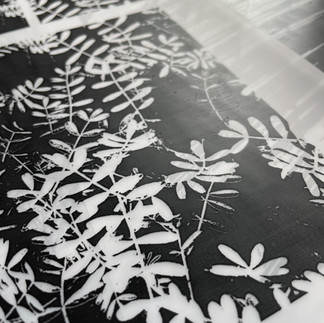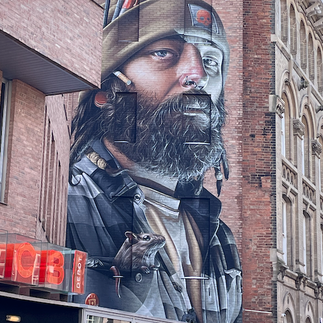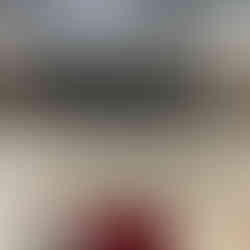Unique printing from nature - What's the joy of Solar Plate Print making?
- Su France
- Mar 26, 2023
- 4 min read
Updated: May 18, 2023

Why solar plates?
As a nature inspired artist, I was pleased to find a new way of illustrating what inspires me through this technique- printmaking from nature, using solar plates.
Through this method, I can make prints of many things. A vast scene such as seaweed jewelled seascapes, substantial plants such as teasels (which couldn't be pressed) and dandelion or goatsbeard seed heads which are too delicate to transfer to print with the other methods I employ.
I have also photographed marks I have made with sumi ink, as I can create movement, playful and gestural, which may then be incorporated into a print. Solar plates are made from a polymer-based material that is sensitive to ultraviolet light.
Once I am happy with a design, this is transferred onto a transparent film, which is then placed onto the solar plate and exposed to UV light.
The beginning Of the Print Process
The designs I create start with a walk in nature, being captured within a frame on my camera; they are then imported into a photo editing tool, in order to create contrast with the black and white tones- something necessary for a successful image transfer.
The areas of the plate that are exposed to the light harden, while the unexposed areas remain soft. I use a UV exposure unit in the Print Workshop in Leicester, (with nearby fantastic huge street graffiti, created during previous 'Bring the Paint' graffiti festivals) where I am a member. Precision is the key here, as I have to take care to expose the plate first with an aqua tint screen. It's a time when I really need to focus, as I have to press buttons to ensure a vacuum is tight on the plate so the image may be transferred in an accurate way. At this point I have to be anti-social and completely focus on the job in hand, there are also timers to watch and seconds to count.
A UV vacuum unit is used to expose a solar plate because it emits ultraviolet light, which activates the photosensitive coating on the plate. This process creates a chemical reaction that hardens the coating in the areas exposed to the UV light, allowing for the creation of an image on the plate. The vacuum is also used to secure the solar plate in place during the printing process, ensuring that it remains stationary while the light cures the plate. That childlike glee comes in when you see the vacuum at work, rapidly sucking all the air out and 'suckering' (not a technical term but you know what I mean!) so the image is ready to be transferred down.
Exposing A Plate
An aquatint screen is exposed onto a photo polymer sheet prior to a solar plate being exposed to the transparent film, because it helps to create a range of detail in the final image. This allows for different levels of light to pass through during the exposure process. The results are a more nuanced and detailed image, compared to a simple black and white one. The use of an aquatint screen is particularly important in the printing processes where a high level of detail is desired, such as during my intaglio printing. Its these intricacies and unique plant qualities which bring me joy.
Reasons for using Solar Plates
Next job: After washing the plate, the hardened areas remain raised and can be inked and printed using my printing press. I usually do this part at home on my faithful Gunning etching press.This technique allows for:
fine details
textures
to be captured in my final print. Solar plate printing is a sustainable alternative to traditional etching techniques, as it uses less toxic chemicals and produces less waste, which are all reasons why I favour it.
Safe Lights in the Dark Room
A red light (safe light) is used in the dark room when washing the photopolymer plates because red light has a longer wavelength than other colours, which means it is less likely to accidentally overexpose the photosensitive material on the plate. This allows me to see what I'm doing without ruining the image.
The white light can go back on as soon as the plate is thoroughly washed. When moving from the UV vacuum machine to the darkroom, I also stay away from windows and once the door is shut and I hide in the shadows (no vampire tendencies, honestly) I try my hardest to keep others coming into the room!
The Washout Processes
There are recommended temperatures for washing out photopolymer because this range optimises the chemical reaction between the photopolymer and the washout solution (water), allowing for efficient removal of unexposed areas from the plate while preserving the image.
The washout processes involves letting the plate sit in the wash tray, removing the photopolymer and agitating the plate in the water, this is gently lifting the tray up and down to create very small waves. Doing this also helps to remove any unexposed photopolymer, leaving only the areas that were exposed to light on the plate.
Completing a Print Run
This quite lengthy process; photographing, manipulating, transparency making, exposing, and washing, helps to create a high-quality image on the solar plate, (which are quite beautiful objects themselves) even before I get to soaking paper, mixing colours, inking up, printing and drying the completed pieces.

It also allows me to print short run, limited edition prints. Each one is subtly different, because each pull is in the lap of the printing gods, and wow do I have to be nice to them. The prints on the left combine collagraph images (the pebbles) with solar plates (the seaweed embellished coastline).
My solar plates are available to buy here in my online shop, at print fairs and in the galleries, who stock my unique nature inspired art.
Here are some examples of prints I have created using this technique.
I'd be interested to hear your thoughts, as its a technique I am to explore further.
I have a few reference books to recommend too if any of you are interested and might write a blog post about my inspiring art books soon.


Currently, this 'Scottish Shoreline' solar plate print is on my website, available to purchase, here.




































